Here’s How: Embodied Carbon
Eliminating embodied carbon – the emissions from the manufacture, transportation, installation, maintenance, and disposal of building materials – is key to addressing climate change. This podcast explores how designers of buildings and communities can apply fresh thinking and best practices to reduce embodied carbon in the built environment.
Episodes

Tuesday Jul 23, 2024
Ep. 10: 9 Minutes on Timber, Nature’s Low Carbon Material
Tuesday Jul 23, 2024
Tuesday Jul 23, 2024
In this episode, host Amy Hattan talks with Chris Williams, a structural engineer and associate principal in Thornton Tomasetti’s Portland, Maine office. Chris discusses his work on developing embodied-carbon specifications for timber, sharing insights on the potential and complexities involved in using mass timber to reduce embodied carbon in construction. He explains timber’s biogenic carbon storage and its lower global warming potential as well as the role of certification programs like the Forest Stewardship Council (FSC), and the importance of considering local supply chains and transportation emissions.
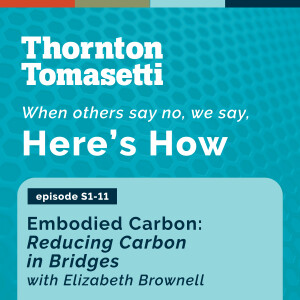
Tuesday Sep 10, 2024
Ep. 11: 11 Minutes on Embodied-Carbon Reduction for Bridges
Tuesday Sep 10, 2024
Tuesday Sep 10, 2024
In this episode, host Amy Hattan talks with structural engineer Elizabeth Brownell about reducing embodied carbon in bridges. Elizabeth discusses the importance of policies like New York’s Buy Clean Concrete and Executive Order 22 and shares insights on how engineers can measure and optimize embodied carbon throughout a bridge’s design and construction. She also emphasizes the need for changes in Department of Transportation specifications to further reduce carbon emissions in infrastructure projects.
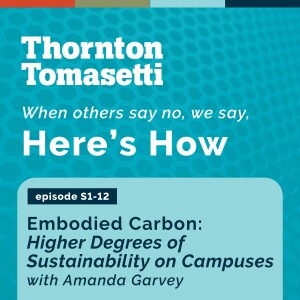
Tuesday Sep 24, 2024
Ep. 12: 9 Minutes on Higher Degrees of Sustainability on Campuses
Tuesday Sep 24, 2024
Tuesday Sep 24, 2024
In this episode, host Amy Hattan talks with Amanda Garvey, a vice president in Thornton Tomasetti’s Sustainability and Resilience practice, about reducing embodied carbon in higher education facilities. Amanda discusses how focusing on Scope 3 emissions from building materials can help colleges and universities meet carbon neutrality goals. She shares ways that certifications like LEED and ILFI promote embodied-carbon reduction and explains how schools can measure, compare and set targets to reduce their carbon footprint. Amanda also emphasizes the role of higher education in driving market change by adopting and standardizing embodied-carbon reporting.
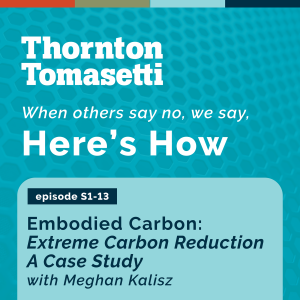
Tuesday Oct 08, 2024
Ep. 13. 12 Minutes on Extreme Carbon Reduction: A Case Study
Tuesday Oct 08, 2024
Tuesday Oct 08, 2024
In this episode, host Amy Hattan talks with Meghan Kalisz, a consultant in Thornton Tomasetti’s Sustainability and Resilience practice, about achieving high levels of embodied carbon reduction in building design. Meghan shares her expertise in life cycle assessment (LCA) and discusses best practices for achieving ambitious embodied-carbon reduction targets. She explains how a rigorous certification programs like Living Building Challenge (LBC) CORE encourages reductions in embodied carbon, with specific targets for building materials such as structural frames and enclosures. Meghan also highlights the use of mass timber and cement replacements, and emphasizes the challenges and solutions involved in reducing embodied carbon, from transportation emissions to insulation choices. The conversation explores how meeting ambitious targets requires receptive clients and partners and looking at every angle for a multi-pronged solution.

Tuesday Oct 22, 2024
Ep. 14. 15 Minutes on The Structural Engineer’s Influence
Tuesday Oct 22, 2024
Tuesday Oct 22, 2024
In this episode, host Amy Hattan talks with Jackson Pitofsky, a structural engineer in Thornton Tomasetti’s Denver office, and co-leader of the firm’s embodied-carbon community of practice assessments working group. Jackson shares practical strategies structural engineers can use to dramatically reduce embodied carbon in the buildings they design. He discusses the impacts of structural system selection and “optioneering” – comparing different systems like steel, concrete, and mass timber material optimization – as well as the importance of specifying low-carbon materials, including cement replacements, and using environmental product declarations (EPDs) to verify embodied-carbon reductions. The conversation covers the importance of collaboration with clients, architects, and contractors for setting clear targets and meeting carbon reduction goals.
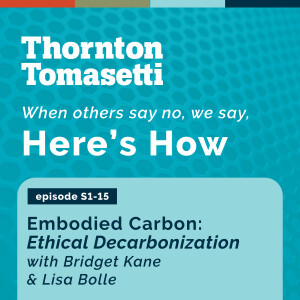
Tuesday Nov 05, 2024
Ep. 15. 13 Minutes on Ethical Decarbonization
Tuesday Nov 05, 2024
Tuesday Nov 05, 2024
In this episode, host Amy Hattan talks with Bridget Kane and Lisa Bolle, leaders of Thornton Tomasetti’s ethical decarbonization working group. Together, they explore how the construction industry can reduce embodied carbon while also addressing labor ethics in material supply chains. They discuss how the manual, labor-intensive manufacturing of materials like solar panels is prone to labor violations, often hidden deep within supply chains. They also review challenges in tracking these risks and emphasize the need for tools like SourceMap to visualize supply chain ethics. Bridget and Lisa also point out that everyone in the AEC industry has a role in building a sustainable, ethical future through solutions such as using vetted materials lists and supporting initiatives like Design for Freedom to push industry-wide change.
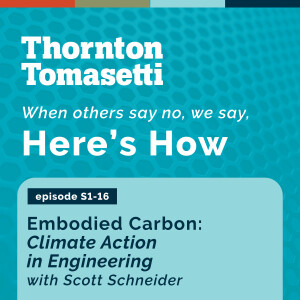
Tuesday Nov 12, 2024
Ep. 16. 12 Minutes on Climate Action in Engineering
Tuesday Nov 12, 2024
Tuesday Nov 12, 2024
In the final episode of the first season, host Amy Hattan speaks with Scott Schneider, Senior Principal and co-leader of Thornton Tomasetti’s Structural Engineering practice, about the role of engineers in meeting the climate-change crisis by making smart, integrated design decisions early in the process. They discuss Scott’s motivations for taking the lead on the firm’s efforts to reduce embodied carbon in all the projects we design. The episode also explores wider AEC-industry opportunities for reducing the negative impacts of buildings on the environment.






